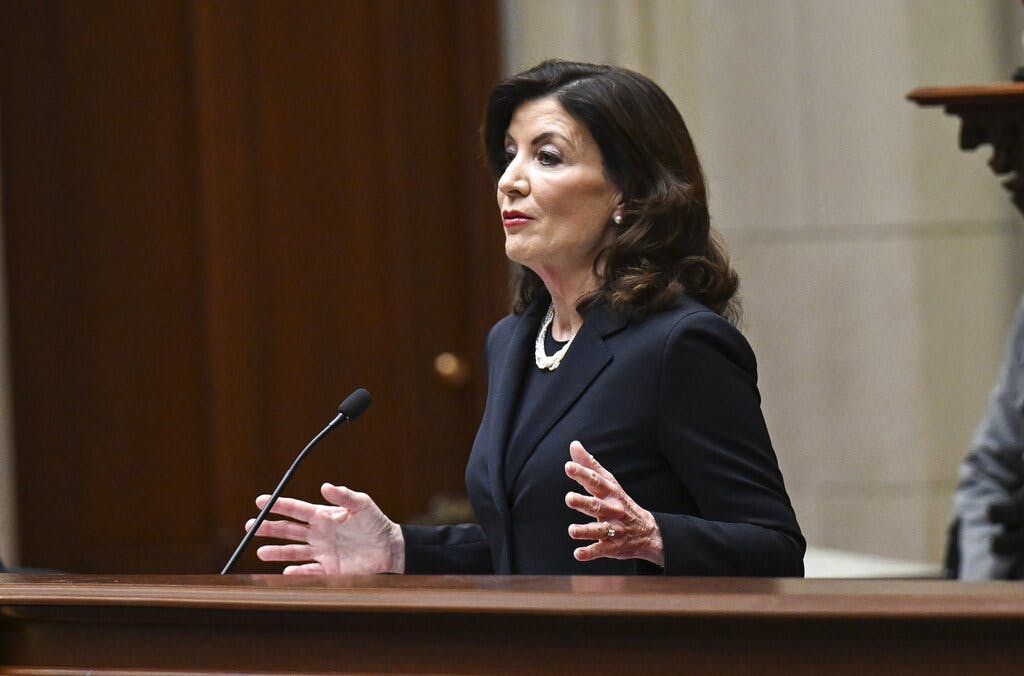New York Taxpayers Are Getting Cheated by Albany Democrats, as Empire State’s Economic Prospects Plunge
Lobbyists crowd the legislature’s hallways, and advocacy groups hold up signs. But no one is representing taxpayers.

If you pay New York state taxes, you’re paying top dollar and getting bupkis. Nothing in the budget deal announced in Albany on Tuesday changes that.
State tax money is supposed to provide services and improve the state’s economic outlook. But a report released last week shows the state’s economic prospects plunging to dead last among the 50 states.
As for services, New York ranks 47th, fourth from the bottom, in what residents get for the money, according to WalletHub.
New York spends the most per public school student, but students perform worse by every measure than students in neighboring states.
New York’s roads rank 45th, according to MoneyGeek. The potholes and pavement roughness cost the average New York driver $715 a year in repairs, fuel and wear and tear. You need a Sherman tank to navigate the Bruckner Expressway.
Why are New York taxpayers getting cheated? Start with the state’s budget process, which ended on Tuesday with a “handshake deal.”
The process is more like a backroom poker game than a legislature doing the public’s business. Three people — the governor, assembly speaker and Senate majority leader — together with a few staff members, haggle behind closed doors. No press, no public.
Occasionally, a legislative committee chair is consulted, but that means only Democrats. Republicans, in the minority, are frozen out.
Lobbyists crowd the legislature’s hallways, and advocacy groups hold up signs. But no one is representing taxpayers.
Now that the deal is brokered, lawmakers will be told to vote on it without time to even read it.
Lawmakers are scheduled to leave Albany by June 6 and not return until 2025, when the budget cycle begins again. Nice work — $142,000 a year for 61 days in session and no follow-up on how tax dollars are spent.
The results are predictably dismal. In 2023, the Empire State’s economy barely grew.
Now New York’s economy is predicted to fall to last place among all 50 states in the coming year, according to a new report from the American Legislative Exchange Council and economists Arthur Laffer and Stephen Moore.
What’s to blame? The highest combined state and local tax burden of any state, as well as high workers’ compensation costs and energy costs that eat away at a business’s bottom line. These issues are fixable.
Another fixable issue is New York’s roads. A staggering 30 percent are in poor condition. Don’t blame weather. New Hampshire spends roughly one-third as much per lane mile on road repairs as New York but has mostly excellent roads.
In 2022, Governor Hochul declared war on potholes and launched a $100 million Pave Our Potholes program. But MoneyGeek found that “more spending on roads did not necessarily lead to better road quality.” Check out union work rules, for starters.
More money also doesn’t buy better schools. New Yorkers spend the most per pupil — a whopping $26,571, compared with a national average of $14,347.
Ms. Hochul proposed adjusting state aid because most districts outside New York City have declining enrollments. The pushback from teachers unions and other groups was too much for a weak governor, and the idea was shelved until next year.
Legislators should insist that state aid to a school district be contingent on improvements in test scores. If you hired a tutor for your own child, and your child didn’t learn anything, would you keep paying?
New York lawmakers should also investigate the huge cost of dual-language classrooms. Nationally, only 3 percent of 12th graders in these classes graduate able to speak and read English, dooming the rest to poverty.
A taxpayer-be-damned attitude also explains why the state’s Medicaid program is paying a mind-blowing 566,000 home health aides.
In 2016, the state launched a program to pay family members to take care of loved ones at home instead of sending them to nursing homes or hiring strangers. Fair enough.
There’s been no decline in nursing home enrollment, though, and it’s implausible that over half a million households need home health care.
Ms. Hochul’s budget deal puts all home care arrangements under one company’s oversight, which might curb abuse, in exchange for hiking what personal care workers get paid. It’s a start.
Tell Albany lawmakers their job is not to rubber-stamp a budget, with problems unsolved, and go home. They need to ensure our hard-earned tax money is spent wisely, before New York ranks dead last in everything.
Creators.com

